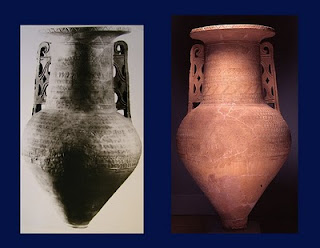 |
| Courtesy of Christos Tsirogiannis |
Doubts have already been raised by eminent archaeologist Christos Doumas that the collection contains modern creations. Have these concerns been addressed by those who have organised this display of ungrounded material?
Earlier this week a delegation from the Hellenic Ministry of Culture accepted the return of three items from the Michael C. Carlos Museum. Two of the pieces, a Minoan larnax and a funerary sculpture, were returned on the basis of their identification (by Christos Tsirogiannis) in the Becchina photographic archive. Yet Tsirogiannis has been able to identify at least one of the Stern figures in the same archive.
At the same time five of the Stern figures are catalogued as part of the Keros haul. (The Hellenic authorities overlooked the Keros haul material at the Michael C. Carlos Museum even though they had taken action when the fragments were auctioned in London.)
It seems that some have not taken steps to learn about the material and intellectual consequences of collecting Cycladic figures.








